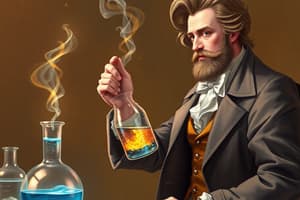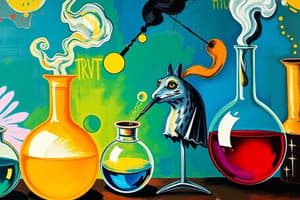Podcast
Questions and Answers
What pivotal conceptual shift did Lavoisier's experiments bring about in the understanding of water's composition?
What pivotal conceptual shift did Lavoisier's experiments bring about in the understanding of water's composition?
- They demonstrated that water is a compound formed by the chemical combination of hydrogen and oxygen. (correct)
- They confirmed that water is a fundamental element that cannot be broken down further.
- They proved that water is created from the reaction between acids and metals.
- They validated the phlogiston theory by isolating phlogiston within water.
In what capacity did heat function within Lavoisier's experimental setup involving 'inflammable air' (hydrogen) and oxygen?
In what capacity did heat function within Lavoisier's experimental setup involving 'inflammable air' (hydrogen) and oxygen?
- As a solvent, dissolving hydrogen gas to facilitate its interaction with other substances.
- As a catalyst, accelerating the reaction between hydrogen and oxygen to produce water. (correct)
- As an inhibitor, regulating the speed at which hydrogen and oxygen combined.
- As a reactant, directly contributing to the formation of water molecules.
How did Lavoisier's nomenclature contribute to a clearer understanding of the gases involved in his experiments?
How did Lavoisier's nomenclature contribute to a clearer understanding of the gases involved in his experiments?
- His renaming of 'inflammable air' to 'hydrogen' reflected its role in the creation of water, aiding conceptual clarity. (correct)
- His labels obscured the true nature of the gases, leading to further confusion among his contemporaries.
- His terminology was intended to align with existing theories, reinforcing traditional explanations.
- His choice of names was purely arbitrary and aimed only to distinguish between different gases.
If Lavoisier had continued to adhere to the phlogiston theory, how might his interpretation of the 'inflammable air' experiment have differed?
If Lavoisier had continued to adhere to the phlogiston theory, how might his interpretation of the 'inflammable air' experiment have differed?
In modern terms, what is the significance of Lavoisier definitively stating that water is composed of hydrogen and oxygen, disproving the phlogiston theory?
In modern terms, what is the significance of Lavoisier definitively stating that water is composed of hydrogen and oxygen, disproving the phlogiston theory?
Antoine Lavoisier's investigation of 'dephlogisticated air,' originally discovered by Joseph Priestley, contributed to what fundamental shift in chemical understanding?
Antoine Lavoisier's investigation of 'dephlogisticated air,' originally discovered by Joseph Priestley, contributed to what fundamental shift in chemical understanding?
How did Lavoisier's experiment involving the burning of a diamond contribute to the development of modern chemistry?
How did Lavoisier's experiment involving the burning of a diamond contribute to the development of modern chemistry?
Which of the following best describes the significance of Antoine-Laurent Lavoisier's work?
Which of the following best describes the significance of Antoine-Laurent Lavoisier's work?
How did Antoine-Laurent Lavoisier's early life experiences contribute to his scientific pursuits?
How did Antoine-Laurent Lavoisier's early life experiences contribute to his scientific pursuits?
What was the most significant impact of Lavoisier's Elementary Treatise on Chemistry (1789) on the field of chemistry?
What was the most significant impact of Lavoisier's Elementary Treatise on Chemistry (1789) on the field of chemistry?
How did Lavoisier's analysis of water contribute to overturning existing scientific beliefs?
How did Lavoisier's analysis of water contribute to overturning existing scientific beliefs?
What role did Marie-Anne Lavoisier play in Antoine-Laurent Lavoisier's scientific work?
What role did Marie-Anne Lavoisier play in Antoine-Laurent Lavoisier's scientific work?
Which principle, central to modern chemistry, is best exemplified by Lavoisier's meticulous quantitative experiments, such as those involving combustion?
Which principle, central to modern chemistry, is best exemplified by Lavoisier's meticulous quantitative experiments, such as those involving combustion?
In 1772, Lavoisier proved elements can have different forms. Which of the following experiments led to this conclusion?
In 1772, Lavoisier proved elements can have different forms. Which of the following experiments led to this conclusion?
Lavoisier's experimental approach significantly differed from that of his predecessors. Which statement accurately describes a key aspect of this difference?
Lavoisier's experimental approach significantly differed from that of his predecessors. Which statement accurately describes a key aspect of this difference?
How did Lavoisier's involvement with the Ferme Générale impact his scientific career?
How did Lavoisier's involvement with the Ferme Générale impact his scientific career?
Suppose Lavoisier is repeating Priestley's experiments but with more precise measurements. Which outcome would most strongly support Lavoisier's law of conservation of mass?
Suppose Lavoisier is repeating Priestley's experiments but with more precise measurements. Which outcome would most strongly support Lavoisier's law of conservation of mass?
Considering Lavoisier's work in disproving the phlogiston theory and establishing the role of oxygen in combustion, what was the broader impact of his research on the future of scientific inquiry?
Considering Lavoisier's work in disproving the phlogiston theory and establishing the role of oxygen in combustion, what was the broader impact of his research on the future of scientific inquiry?
Consider a hypothetical scenario: Lavoisier is experimenting with a new gas and observes that it supports combustion more vigorously than ordinary air. Based on his known discoveries, what would be his most likely hypothesis?
Consider a hypothetical scenario: Lavoisier is experimenting with a new gas and observes that it supports combustion more vigorously than ordinary air. Based on his known discoveries, what would be his most likely hypothesis?
Which statement reflects a limitation in Lavoisier's experimental techniques, given the context of his era?
Which statement reflects a limitation in Lavoisier's experimental techniques, given the context of his era?
How did Lavoisier's experiments with sulfur and phosphorus challenge the phlogiston theory?
How did Lavoisier's experiments with sulfur and phosphorus challenge the phlogiston theory?
What was the significance of Priestley's 'dephlogisticated air' in Lavoisier's experiments?
What was the significance of Priestley's 'dephlogisticated air' in Lavoisier's experiments?
How did Lavoisier's discovery regarding the composition of water contribute to the development of modern chemistry?
How did Lavoisier's discovery regarding the composition of water contribute to the development of modern chemistry?
In what way did Lavoisier's 'Elementary Treatise on Chemistry' (1789) revolutionize the field of chemistry?
In what way did Lavoisier's 'Elementary Treatise on Chemistry' (1789) revolutionize the field of chemistry?
Why was it essential for Lavoisier to have access to a laboratory when he became commissioner of the Royal Gunpowder Administration?
Why was it essential for Lavoisier to have access to a laboratory when he became commissioner of the Royal Gunpowder Administration?
How did Lavoisier's systematic approach to chemical experimentation differ from those of his predecessors who supported the phlogiston theory?
How did Lavoisier's systematic approach to chemical experimentation differ from those of his predecessors who supported the phlogiston theory?
Lavoisier's experiments with mercury calx directly demonstrated which of the following principles?
Lavoisier's experiments with mercury calx directly demonstrated which of the following principles?
What pivotal role did quantitative measurement play in Lavoisier's refutation of the phlogiston theory, and how did it change chemical practices?
What pivotal role did quantitative measurement play in Lavoisier's refutation of the phlogiston theory, and how did it change chemical practices?
How did Lavoisier's work transforming chemistry align with or diverge from the scientific revolution's broader goals?
How did Lavoisier's work transforming chemistry align with or diverge from the scientific revolution's broader goals?
How did Lavoisier's sealed container experiments challenge existing theories about mass changes during chemical reactions?
How did Lavoisier's sealed container experiments challenge existing theories about mass changes during chemical reactions?
Lavoisier's role as commissioner of the Royal Gunpowder Administration afforded him unique access to resources. How might these resources have directed or biased his research?
Lavoisier's role as commissioner of the Royal Gunpowder Administration afforded him unique access to resources. How might these resources have directed or biased his research?
Lavoisier's identification of 'azote' (nitrogen) was significant because it demonstrated which of the following about air?
Lavoisier's identification of 'azote' (nitrogen) was significant because it demonstrated which of the following about air?
How might the social and political context of pre-revolutionary France have influenced Lavoisier’s chemical research, including his focus and acceptance?
How might the social and political context of pre-revolutionary France have influenced Lavoisier’s chemical research, including his focus and acceptance?
What was the most significant conclusion Lavoisier drew from his experiments comparing guinea pig respiration to the burning of carbon?
What was the most significant conclusion Lavoisier drew from his experiments comparing guinea pig respiration to the burning of carbon?
How did Lavoisier's work directly lead to the overthrow of the phlogiston theory?
How did Lavoisier's work directly lead to the overthrow of the phlogiston theory?
Which statement best encapsulates the core principle of the Law of Conservation of Mass as established by Lavoisier?
Which statement best encapsulates the core principle of the Law of Conservation of Mass as established by Lavoisier?
Consider Lavoisier's experimental approach. Which of the following practices was most crucial to his success in advancing chemistry?
Consider Lavoisier's experimental approach. Which of the following practices was most crucial to his success in advancing chemistry?
If Lavoisier had access to modern analytical techniques (e.g., mass spectrometry), how might his conclusions about the Law of Conservation of Mass be refined or expanded?
If Lavoisier had access to modern analytical techniques (e.g., mass spectrometry), how might his conclusions about the Law of Conservation of Mass be refined or expanded?
Imagine Lavoisier is investigating a new reaction where a precipitate forms. How would he ensure the Law of Conservation of Mass is upheld in his experiment?
Imagine Lavoisier is investigating a new reaction where a precipitate forms. How would he ensure the Law of Conservation of Mass is upheld in his experiment?
Considering the broader scientific impact, which of the following best describes Lavoisier's most profound contribution to the field of chemistry?
Considering the broader scientific impact, which of the following best describes Lavoisier's most profound contribution to the field of chemistry?
Flashcards
Element Forms
Element Forms
Discovery that elements can exist in different forms demonstrated by burning a diamond.
Dephlogisticated air
Dephlogisticated air
Term used by Joseph Priestley, which Lavoisier investigated and confirmed its properties.
Hydrogen
Hydrogen
Lavoisier coined this term while analyzing water as a compound of two gases.
Elementary Treatise on Chemistry
Elementary Treatise on Chemistry
Signup and view all the flashcards
Water Composition
Water Composition
Signup and view all the flashcards
Lavoisier's Experiment
Lavoisier's Experiment
Signup and view all the flashcards
Chemical Revolution
Chemical Revolution
Signup and view all the flashcards
Lavoisier's Birth Year
Lavoisier's Birth Year
Signup and view all the flashcards
Conservation of Mass
Conservation of Mass
Signup and view all the flashcards
Discovery of Oxygen
Discovery of Oxygen
Signup and view all the flashcards
Contribution of Marie-Anne
Contribution of Marie-Anne
Signup and view all the flashcards
Element Forms Discovery Year
Element Forms Discovery Year
Signup and view all the flashcards
Ferme Générale Involvement
Ferme Générale Involvement
Signup and view all the flashcards
Influence of Joseph Priestley
Influence of Joseph Priestley
Signup and view all the flashcards
Law of Combustion
Law of Combustion
Signup and view all the flashcards
Phlogiston Theory
Phlogiston Theory
Signup and view all the flashcards
Lavoisier's Commission
Lavoisier's Commission
Signup and view all the flashcards
Combustion Experiment
Combustion Experiment
Signup and view all the flashcards
Joseph Priestley
Joseph Priestley
Signup and view all the flashcards
Pure Air
Pure Air
Signup and view all the flashcards
Water as a Compound
Water as a Compound
Signup and view all the flashcards
Hydrogen Coinage
Hydrogen Coinage
Signup and view all the flashcards
1789 Chemistry Textbook
1789 Chemistry Textbook
Signup and view all the flashcards
Lavoisier's Legacy
Lavoisier's Legacy
Signup and view all the flashcards
Combustion and Air Interaction
Combustion and Air Interaction
Signup and view all the flashcards
Cavendish's Inflammable Air
Cavendish's Inflammable Air
Signup and view all the flashcards
Lavoisier's Heat Catalyst
Lavoisier's Heat Catalyst
Signup and view all the flashcards
Water Composition Discovery
Water Composition Discovery
Signup and view all the flashcards
Lavoisier's Renaming
Lavoisier's Renaming
Signup and view all the flashcards
Law of Conservation of Mass
Law of Conservation of Mass
Signup and view all the flashcards
Candle in a Sealed Jar
Candle in a Sealed Jar
Signup and view all the flashcards
Discovery of Nitrogen
Discovery of Nitrogen
Signup and view all the flashcards
Combustion and Respiration
Combustion and Respiration
Signup and view all the flashcards
Mass Gain After Heating
Mass Gain After Heating
Signup and view all the flashcards
Equivalence of Oxygen
Equivalence of Oxygen
Signup and view all the flashcards
Mercury Calx Experiment
Mercury Calx Experiment
Signup and view all the flashcards
Chemical Reaction Weights
Chemical Reaction Weights
Signup and view all the flashcards
Respiration vs. Combustion
Respiration vs. Combustion
Signup and view all the flashcards



